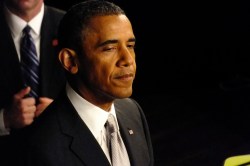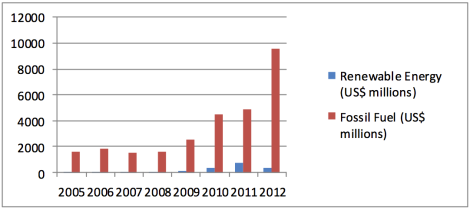
Stephen KoigiObama addressing an audience in Cape Town, South Africa, on Sunday.
President Obama said on Monday that it’s “unacceptable” that more than two-thirds of sub-Saharan Africans don’t have access to electricity, and he has a plan to help solve the problem. On Sunday, he unveiled a new Power Africa initiative intended to double electricity access in the region.
The initiative calls for more than $7 billion in U.S. funding over five years to help build new power plants in six African countries and bring electricity to more than 20 million households and businesses. It’s also intended to help American companies get a foothold in Africa.
Obama introduced the program in a speech in South Africa on Sunday:
Now we’re going to talk about power — Power Africa — a new initiative that will double access to power in sub-Saharan Africa. Double it. We’re going to start by investing $7 billion in U.S. government resources. We’re going to partner with the private sector, who themselves have committed more than $9 billion in investment. And in partnership with African nations, we’re going to develop new sources of energy. We’ll reach more households not just in cities, but in villages and on farms. We’ll expand access for those who live currently off the power grid. And we’ll support clean energy to protect our planet and combat climate change.
Clean energy sounds good, but how much of the new electricity will be clean? Not all. Here’s what the White House says in a fact sheet: “Power Africa will build on Africa’s enormous power potential, including new discoveries of vast reserves of oil and gas, and the potential to develop clean geothermal, hydro, wind and solar energy.” Planned projects include the first large-scale wind projects in Kenya and Tanzania, as well as biomass mini power plants in Tanzania. The plan also calls for helping Uganda and Mozambique develop their oil and gas resources in a “transparent and environmentally sustainable manner.”
One big outstanding question: Will coal plants be involved? In his big climate speech last week, Obama called for “an end to public financing for new coal plants overseas unless they deploy carbon-capture technologies, or there’s no other viable way for the poorest countries to generate electricity.” Will the administration stick to that no-new-coal-plant pledge, or try to use the no-other-viable-way loophole?
It’s not heartening to see that the bulk of the funding for Power Africa — $5 billion — will be in the form of loans and financing assistance administered by the U.S. Export-Import Bank (Ex-Im), which has a dirty record when it comes to power projects.
From an April post in the Sierra Club’s Compass blog:
Under [Chairman Fred] Hochberg’s leadership, the bank has ignored a Congressional mandate to direct 10% of financing towards renewables, and instead gone on a fossil fuel bender. Ex Im approved $900 million in financing for the 4,000 megawatt Sasan coal-fired power station in India, which displaced entire villages and used dangerous labor practices that lead to worker deaths. It directed $800 million in financing for the 4,800 MW Kusile power station in South Africa, despite local protests and the fact that the area around the project already exceeded pollution limits set by the South African government. Essentially, the Ex Im Bank is completely at odds with President Obama’s desire to address climate change.
The nonprofit Pacific Environment put together [PDF] this graph that dramatically demonstrates the Ex-Im’s bias for fossil fuel projects:
While it’s encouraging that America intends help Africans gain access to electricity, here’s hoping it isn’t done using the health-ruining and climate-wrecking fossil-fuel technologies of yesteryear.



